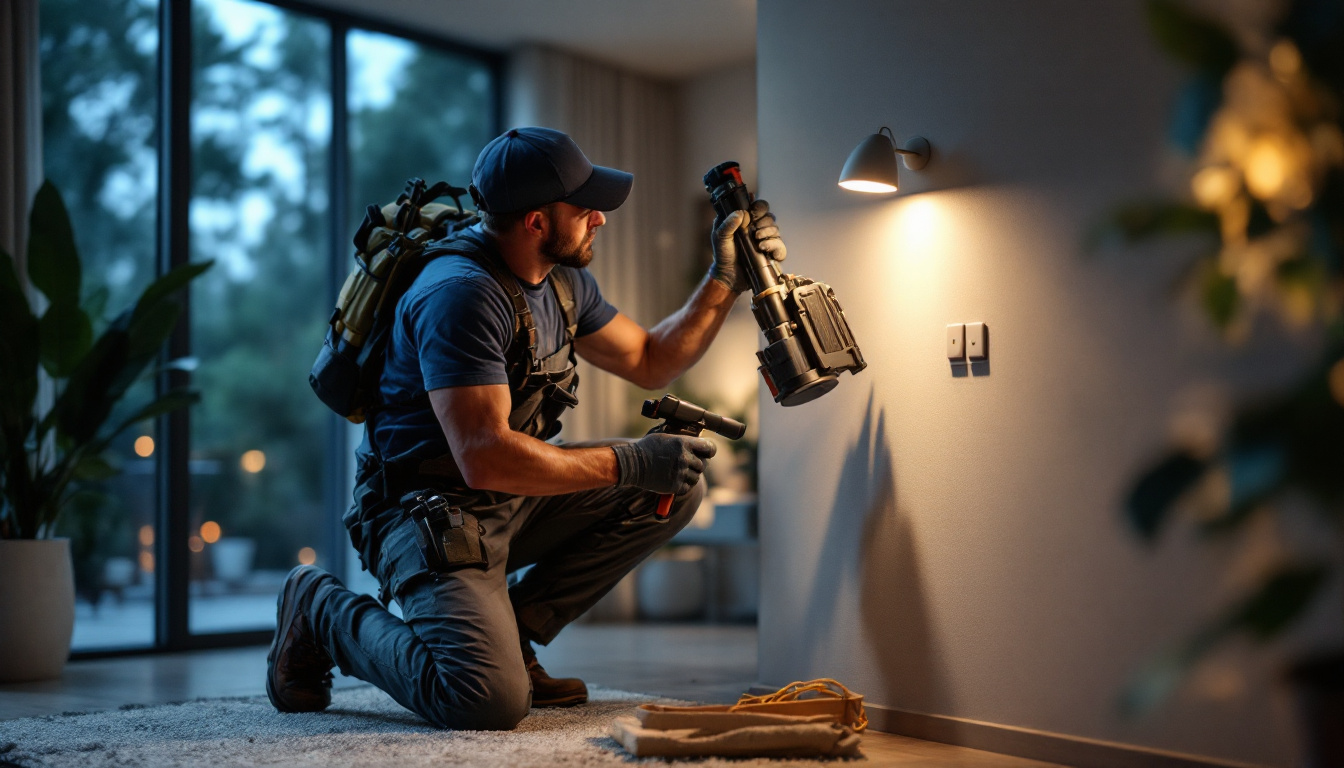
Lighting plays a pivotal role in enhancing the aesthetics and functionality of any space. For lighting professionals, understanding the nuances of lighting design, installation, and maintenance is essential. This article presents a comprehensive checklist tailored for lighting contractors, ensuring that every project is executed with precision and excellence.
Before diving into any lighting project, it is crucial to have a clear understanding of the project scope. This involves assessing the client’s needs, the environment, and the intended use of the space. A thorough initial consultation can set the stage for a successful project. By establishing a comprehensive scope, lighting professionals can ensure that all aspects of the design align with the client’s expectations and the functional requirements of the space.
Engaging with the client is the first step in defining the project scope. Lighting professionals should ask open-ended questions to understand the client’s vision and requirements. This includes discussing the desired ambiance, specific tasks the lighting will support, and any aesthetic preferences. Documenting these details will provide a solid foundation for the design process. Additionally, it can be beneficial to present clients with mood boards or examples of previous projects to facilitate discussion and inspire ideas. This collaborative approach not only fosters a sense of partnership but also helps in refining the client’s vision into actionable design elements.
Conducting a site assessment is equally important. This involves evaluating the physical characteristics of the space, including size, layout, and existing lighting conditions. Identifying potential challenges, such as obstructions or varying ceiling heights, will help in formulating an effective lighting strategy. Taking measurements and photographs can also be beneficial for future reference. Moreover, assessing the natural light sources and how they interact with the space throughout different times of the day can provide valuable insight. Understanding how the light changes can inform decisions on artificial lighting placement and intensity, ensuring a harmonious balance between natural and artificial light.
Once the client’s needs and the site characteristics are understood, it is essential to discuss budget considerations. This discussion should encompass not only the initial costs of materials and installation but also long-term operational costs, such as energy consumption and maintenance. Providing clients with a range of options that fit within their budget can help them make informed decisions. Additionally, discussing the potential for energy-efficient solutions, such as LED lighting or smart controls, can lead to significant savings over time while also enhancing the overall sustainability of the project.
Another critical aspect of defining the project scope is establishing a realistic timeline. This involves outlining key milestones, from the initial design phase through to installation and final adjustments. By setting clear deadlines, both the client and the lighting professional can manage expectations and ensure that the project progresses smoothly. It is also wise to account for potential delays, such as shipping times for specialized fixtures or unforeseen site conditions, which can impact the overall schedule. Regular check-ins and updates can help maintain momentum and keep all parties aligned throughout the project lifecycle.
Once the project scope is established, the next step is to design a comprehensive lighting plan. This plan should incorporate various lighting techniques, fixture types, and control systems to achieve the desired effect. A well-thought-out lighting plan not only illuminates a space but also contributes to the overall mood and functionality, making it an essential aspect of any design project.
There are three primary types of lighting to consider: ambient, task, and accent lighting. Ambient lighting provides overall illumination, task lighting focuses on specific areas for activities, and accent lighting highlights particular features or objects. A well-balanced combination of these lighting types will enhance both functionality and aesthetics. For instance, in a kitchen, ambient lighting can come from ceiling fixtures, while under-cabinet task lighting illuminates countertops for food preparation. Accent lighting can be used to showcase decorative elements, such as artwork or architectural details, adding depth and interest to the space.
Choosing the right fixtures is critical to the success of the lighting design. Factors to consider include the style, size, and energy efficiency of the fixtures. LED options are increasingly popular due to their longevity and low energy consumption. Additionally, the color temperature of the fixtures should align with the desired ambiance; warmer tones create a cozy atmosphere, while cooler tones can energize a space. When selecting fixtures, it’s also important to think about the scale of the room; oversized fixtures can become a focal point in a large space, while smaller fixtures may be better suited for intimate areas. Furthermore, the finish of the fixtures—whether matte, polished, or textured—can also influence the overall design aesthetic, contributing to a cohesive look throughout the environment.
Incorporating advanced lighting controls can significantly enhance the user experience. Dimmers, timers, and smart home integration allow for flexibility and adaptability in lighting design. These controls enable clients to customize their lighting according to their needs, making the space more functional and enjoyable. For example, in a home theater, dimmable lights can create the perfect ambiance for movie nights, while smart controls can adjust the lighting automatically based on the time of day or activity. Additionally, integrating motion sensors can provide convenience and energy savings, ensuring that lights are only on when needed. The ability to control lighting through mobile apps or voice commands adds an extra layer of sophistication, making the lighting plan not just a functional element, but a seamless part of modern living.
The installation phase is where the lighting plan comes to life. A well-organized installation process is essential to ensure that the project is completed efficiently and safely.
Before beginning the installation, it is important to prepare the site. This includes ensuring that all necessary materials and tools are on hand, as well as confirming that the installation team is well-versed in the project details. A pre-installation meeting can help clarify roles and responsibilities, minimizing the risk of miscommunication.
Safety is paramount during the installation process. Lighting professionals must adhere to local electrical codes and regulations. This includes ensuring proper wiring, grounding, and circuit protection. It is advisable to consult with a licensed electrician when dealing with complex electrical systems to avoid potential hazards.
When installing fixtures, attention to detail is crucial. Proper alignment and secure mounting will ensure that the fixtures function as intended and maintain their aesthetic appeal. Additionally, testing each fixture during installation can help identify any issues early on, allowing for prompt resolution.
After the installation is complete, conducting a thorough evaluation is essential. This step ensures that the lighting system operates effectively and meets the client’s expectations.
Testing the lighting system involves checking for functionality, brightness levels, and color accuracy. Adjustments may be necessary to achieve the desired effect. For instance, dimmers may need calibration, or the positioning of fixtures may require fine-tuning to eliminate shadows or glare.
Conducting a walkthrough with the client is an important part of the post-installation process. This allows the client to experience the lighting firsthand and provide feedback. Addressing any concerns or making minor adjustments at this stage can enhance client satisfaction and build trust.
Ongoing maintenance is a crucial aspect of any lighting system. Providing clients with a maintenance plan can help extend the lifespan of the fixtures and ensure optimal performance.
Regular maintenance checks should be scheduled to inspect fixtures, clean lenses, and replace any burnt-out bulbs. This proactive approach can prevent minor issues from escalating into costly repairs. Educating clients on the importance of maintenance can also foster a sense of responsibility for their lighting systems.
Offering ongoing support is essential for building lasting relationships with clients. Providing a troubleshooting guide or a contact for support can empower clients to address minor issues independently. Additionally, being available for follow-up consultations can help clients feel valued and supported.
The lighting industry is constantly evolving, with new technologies and design trends emerging regularly. Staying informed about these changes is vital for lighting professionals to remain competitive and offer the best solutions to clients.
Participating in workshops, webinars, and industry conferences can provide valuable insights into the latest advancements in lighting technology and design. Continuing education not only enhances professional skills but also demonstrates a commitment to excellence in the field.
Networking with other professionals in the lighting industry can lead to collaboration and knowledge sharing. Joining professional organizations and attending local events can facilitate connections and provide access to valuable resources.
For lighting professionals, adhering to a comprehensive checklist is essential for ensuring successful project execution. From understanding the project scope to providing ongoing support, each step plays a critical role in delivering exceptional lighting solutions. By staying informed and committed to excellence, lighting contractors can enhance their reputation and foster long-lasting relationships with clients.
In a rapidly changing industry, the ability to adapt and innovate is key. By following the essential checklist outlined in this article, lighting professionals can navigate the complexities of their projects with confidence, ultimately leading to satisfied clients and successful outcomes.
Ready to elevate your lighting projects with the best in spec-grade lighting products? Look no further than LumenWholesale. We provide lighting professionals like you with top-quality solutions at unbeatable wholesale prices, ensuring your projects shine without straining your budget. With our extensive selection that meets the highest industry standards, you can trust in the reliability and performance of our lighting for every project. Plus, enjoy the convenience of bulk buying with free shipping, and experience the LumenWholesale difference—where quality, affordability, and convenience come together seamlessly. Take the next step in project excellence and explore our Wholesale Lighting at the Best Value today.

Discover effective strategies for training your team in the installation and maintenance of flush mount 3-phase 480V lights.

Explore how unique pendant lighting is revolutionizing the lighting industry, offering contractors innovative design solutions and transforming spaces with style and efficiency.

Discover the advantages of low voltage can lights for lighting contractors, including energy efficiency, enhanced safety, and versatile design options.

Discover how ceiling-integrated lighting transforms efficiency for contractors.